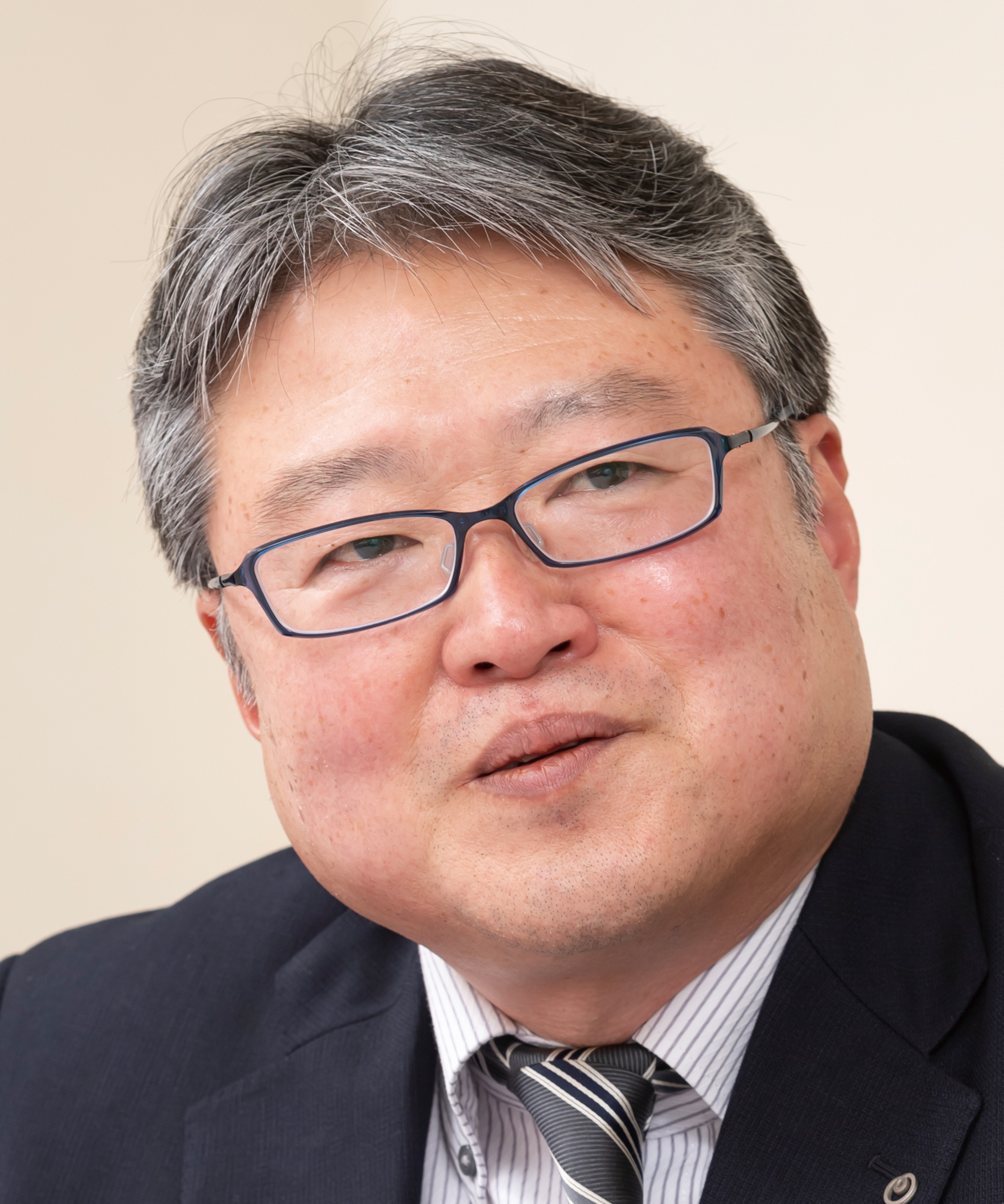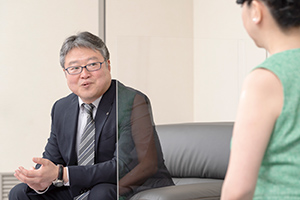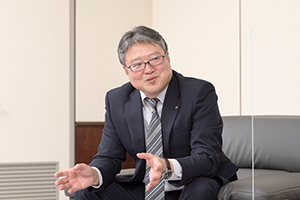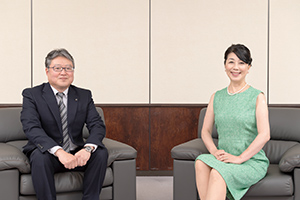 |
|
|
|
|
|
View from the Top Vol. 19, No. 7, pp. 1–6, July 2021. https://doi.org/10.53829/ntr202107tp1
Creating a Communication-rich Environment by Making the Most of Researchers’ Diverse PersonalitiesOverviewThe NTT Science and Core Technology Laboratory Group is engaged in research and development with the following three missions: “Research and development of cutting-edge technologies to expand NTT’s business domains,” “Creation of new principles and concepts that will revolutionize society,” and “Research and development of technologies that are friendly to the global environment and people.” To contribute to society, the laboratory group is creating new values through the results of its research while keeping an eye on current trends. We interviewed Tetsuomi Sogawa, senior vice president, head of the NTT Science and Core Technology Laboratory Group, about the social mission of the laboratory group and mindset required for researchers to lead the world. Keywords: NTT Science and Core Technology Laboratory Group, R&D, IOWN Researchers, sharpen your saws!—Please tell us about the vision and social mission of the NTT Science and Core Technology Laboratory Group. The NTT Science and Core Technology Laboratory Group is conducting a wide range of research and development (R&D)—from basics to applications—while always looking at how to create a future with technologies. Specifically, we are focusing on information-processing and communication technologies with the highest performance in the world, sustainable technologies that enable the creation of new value through innovative ideas, and human science and biotechnology that deepen the understanding of humans. By achieving world-best, world-first technologies or creating amazing technologies, we aim to strengthen the competitiveness of the NTT Group while making the concept of the Innovative Optical and Wireless Network (IOWN) a reality. The NTT Science and Core Technology Laboratory Group consists of four laboratories: the Network Innovation Laboratories, Device Technology Laboratories, Communication Science Laboratories, and Basic Research Laboratories. The Network Innovation Laboratories is researching and developing budding technologies that will expand the world’s highest-level optical- and wireless-communication capacity and area coverage. The Device Technology Laboratories is researching and developing devices and materials that will create new value. To make innovative technologies available to a wide range of industries seamlessly, the Device Technology Laboratories is working closely with the Device Innovation Center, which is in charge of device development at the IOWN Integrated Innovation Center. The Communication Science Laboratories researches media, information processing, and human sciences to enable communication that reaches the heart, and the Basic Research Laboratories researches materials science, electronic physical properties, and optical physical properties for creating new principles and concepts that break the limits of network technology. In the mid-1980s, Japanese companies established basic and central research laboratories one after another. However, after Japan’s bubble economy burst, those companies began to cease these activities, and the number of existing basic research labs is very small. Since it is extremely difficult to renew social infrastructure once it was constructed, corporate research labs are required to create technology with a bird’s-eye view of the future. To bring better technology to the world, we regard researching from theories and basic principles of things as important, and this stance is one of our strengths. —It has been reported that in Japan, researchers are not as highly evaluated as researchers in the rest of the world and that research funding is low. That is a difficult issue. For example, a smartphone contains a processor equivalent to a supercomputer of the past. Unfortunately, the efforts of the researchers who made it possible have been hidden behind the impact of the product, and they are not well known. Researchers may not be good at telling people about the fruits of their challenging research results; even so, the tasks that research labs and researchers have to perform differ from those they had to perform a while ago, and one of those tasks is to convey the significance of their research. We must recognize that this task is a much tougher challenge than we imagined. World’s-first achievements do not always provide the highest quality, and since they are new, people cannot comprehend them well. Consequently, when we talk to someone about such achievements, we almost always get a negative reaction. We can gain their cooperation only after we convince ourselves that our research is superior and continue to explain it to those around us. When I was the vice president, head of the Basic Research Laboratories, we tried to give easy-to-understand explanations to journalists when we made a press release; however, they were still difficult to understand. Therefore, we used a live-streaming service called “Niconico Live” to convey the significance of our research to a general audience and answered questions from them. I think it was a good endeavor because researchers came to better understand the essence of their research by repeatedly explaining them in the live-streaming service. In the days when Japan was simply following the research of other countries, we knew what needed to be researched. All we had to do was increase the performance of products through continuous improvements. However, Japan has become one of the top countries of scientific research and is in a position to provide guidance on research. Our role is to set the rules for what problems should be solved and themes to be tackled in the next generation. In other words, we are expected to not only solve the problems for continuous improvement but also make breakthroughs. However, I feel that Japanese researchers are still not very good at meeting such expectations. Although it is very difficult to identify the next generation of research problems, as a starting point, it is important to review the problems we are working on from a different perspective. Therefore, I often tell researchers, “Sharpen your saws!” There is a story of the woodcutter’s dilemma, in which the woodcutter would eventually cut trees using his dull saw if he spends a lot of time doing so, but if he paused and sharpened his saw, he would have cut them more efficiently. If we can apply this story in our research and successfully “sharpen our saws,” we can discover new solutions to the problems we are currently facing. Moreover, by comparing our perspectives with global trends and taking a bird’s-eye view of things, we may be able to find new themes and solutions to be tackled.
Having an optimistic mindset is necessary when conducting basic and cutting-edge research—Do you have any tips for making breakthroughs? NTT R&D has a long history of conducting meetings and conferences implemented for the next generation of researchers. For example, in 2000, when I was working in the planning department of the Basic Research Laboratories, we introduced an advisory board. It is unusual for a research lab of a private company to ask for external evaluation; regardless, we had doubts about evaluating the value of NTT R&D solely on our own. Therefore, to borrow the wisdom of experts from overseas, thus advance research that would contribute to future communications and information processing, we launched the advisory board under the leadership of the vice president, head of the Basic Research Laboratories. I was a visiting researcher at the Paul Drude Institute in Germany, so I contacted a professor who was active in Europe in fields relatively close to mine. In the advisory board, for example, it was pointed out that we should focus not only on themes related to superconductivity technologies that will enable quantum computers but also on photonics technologies that will lead to quantum communications, which prompted us to review our research portfolio. The advisory board has been held every two years for more than 20 years, and the board members include Nobel laureates and former chairs of the Nobel-laureate selection committee. The establishment of new job titles such as fellows and senior distinguished researchers was also based on advice from the board, and it has provided researchers with the motivation for working at NTT for a longer time. The BRL (Basic Research Laboratories) School is another initiative taken at the Basic Research Laboratories. The school invites overseas graduate students and postdoctoral researchers, as well as lecturers from Japan and abroad, to foster the next generation of researchers through lectures and discussions. Various summer schools are held in Europe, creating a cycle in which the students who study at such schools become faculty members at universities then become lecturers at later summer schools. I believe that such efforts are indispensable for NTT R&D. In fact, a postdoctoral researcher who participated in the first BRL School is now a professor at a European university and has sent interns to work with us at NTT. It can be geographically difficult to work closely with research communities far from Japan, but that is not a problem as long as we can build a trusting relationship with them. Since what we can do alone is limited, we would like to build relationships in which researchers around the world can bring their strengths to the table. It is therefore unfortunate that most international conferences are currently held online due to the COVID-19 pandemic and we cannot present our research or visit laboratories overseas. Online conferences are different from physical ones in terms of being fully stimulated. By visiting various sites and meetings and talking face to face with various people, we often find new things that we were not aware of until then. —It seems that the stimulation you receive in person is very important. When I was discussing the ultrasonic waves that were used to transport electrons in semiconductors in Germany, researchers told me that NTT had used ultrasonic waves for optical communications in the past. They review an old technology and apply it to electron transport on semiconductor surfaces, and in doing so, they created a new function. That discussion led me to the idea of transport of electron spins—which I was studying at the time—in semiconductors, and after returning to Japan, I continued to work on that research theme while having regular discussions with my German peers. This theme has evolved into research on controlling the state of electron spins in semiconductors and extending their lifetime, and such research has been continuing at the Basic Research Laboratories. In basic and cutting-edge research, we cannot easily achieve good results. Achieving success once a year is regarded as great performance. In fact, most of the research is a series of failures. To face that reality, we need to have an optimistic mindset. There are two types of optimistic people: the “definitely optimistic,” who face situations with confidence, and the “indefinitely optimistic,” who face situations without much evidence to support that mindset. The German researchers that I worked with were definitely optimistic, and they proceed with research on the basis of theories and prospects. In actual research, it is more likely that things will go wrong even when we are confident. When that happens, it is important to compare our experimental results with theories again and change the course of our hypothesis. Certain words and phrases have inspired me. I have had several opportunities to talk with Nobel Laureate Dr. Leo Esaki ever since I was a doctoral student, and he valued the phrase “Think the unthinkable.” He said to me, “You are young, so think the unthinkable. As we age and make mistakes, we gradually develop a judicious mind, but lose our creative mind.” Another phrase that inspired me is “Zero to One,” the title of a book by American entrepreneur Peter Thiel. This phrase, which means “creating something from nothing” is another way of expressing the mission of our laboratory group. We will keep these phrases in mind as we continue to take on a variety of challenges to bring innovation. The job of a manager is to build and protect the environment for innovation. We are trying to create an environment in which rules are kept to a minimum so that researchers can do their research activities freely and their supervisors can support them, which enables us to make the most of their diverse personalities. We believe that this is the best way to achieve results at our group. In particular, if we make researchers think too much about commercial applications of their research results, their ideas will become limited; therefore, I would like to leave concern about applications to someone who has a different role and let our researchers simply focus on achieving interesting results.
The real pleasure of management is when researchers go through a significant transformation—You are a researcher, but now you are in a management position. I think many people want to continue their research activities at the forefront. What is the significance of appointing a researcher as a manager? Since I joined the company as a doctoral graduate, I thought I’d continue in research for a long time, but now I am in a management position. However, even if I stayed at the university and became a researcher, I would have eventually become a faculty member, and half of my work would have been management, so I think I’ve ended up in the same situation in the end. Managers in research laboratories evaluate people who are producing research results at the forefront, so they must be acceptable to the people they evaluate. In addition, the intuition of a researcher is important for being managers in research laboratories when making decisions about the direction of the research. In other words, it is necessary to have deep insights and have the skills to convince others. Some people think that management activities are separate from research activities; on the contrary, I believe that the two activities are closely connected because management activities help us organize our research activities. When I was the vice president, head of the Basic Research Laboratories, I was not in a position to research at the forefront. Therefore, I wrote papers on the basis of my own past experimental data. Naturally, I don’t write papers now as a first author but I have been a joint author on several papers, so I continue to discuss research with frontline researchers. It is unfortunate that I have little time to be involved in research and writing papers; however, many people are conducting outstanding research, and I believe that my current job is to encourage them. I am impressed when I see an ingenious approach that differs from my own ideas. When researchers go through a significant transformation, I feel the real pleasure of R&D management. As researchers change themes and accumulate various experiences, they sometimes grow rapidly toward their next step. I am happiest when researchers express their viewpoints and show me results that are beyond what I had expected. The concept of IOWN proposed by NTT R&D and one of its components, the All-Photonics Network, is a vision that meets the long-term goal of our laboratory group. What I had set out to do 30 years ago when I was a fledgling researcher is starting to look like a reality. Therefore, I believe it is important to start planning our next initiatives now by looking ahead 30 years from now. By steering the ship so that it does not drift in the wrong direction, we at the NTT Science and Core Technology Laboratory Group would like to take a leadership role in the world by working with researchers to come up with ideas and provide a roadmap to achieve them. —What would you like to say to the researchers and engineers inside and outside the company? The creation of new technologies and innovations is essential for Japan to survive. I hope that researchers and engineers will continue to play their role with that mission in mind. Japan’s technological capabilities have always been high, but I feel that Japanese researchers are not good at creating rules and becoming leaders of trends. To increase our research and technological capabilities, let’s set our direction and show a vision to stay on top of the world. Japanese researchers are very talented, but in the past, many seemed shy and not good at asserting themselves. However, the younger generation has changed quite a bit. At international conferences, I often see young researchers get the most out of their participation; they try to learn about fields other than their own and obtain knowledge by actively asking questions. They look confident and have a promising future. The battle for technological supremacy is extremely fierce, so let’s regain our spirit and liven up Japan.
Interviewee profileCareer highlightsTetsuomi Sogawa joined NTT Basic Research Laboratories in 1991. From 1999 to 2000, he was a guest scientist at Paul Drude Institute in Berlin, Germany, where he investigated acoustic spin transport phenomena in semiconductor quantum structures. From 2004 to 2006, he worked for the Council for Science and Technology Policy, Cabinet Office, Japan, as a deputy director for policy planning. He became senior research scientist at NTT Basic Research Laboratories in 2006; executive manager of Research Planning Section, NTT Science and Core Technology Laboratory Group, in 2007; group leader of Quantum Optical Physics Research Group, NTT Basic Research Laboratories, in 2010; executive manager of Optical Science Laboratory, NTT Basic Research Laboratories, in 2012; and the vice president, head of NTT Basic Research Laboratories in 2013. He has been in his current position since June 2018. |
|












